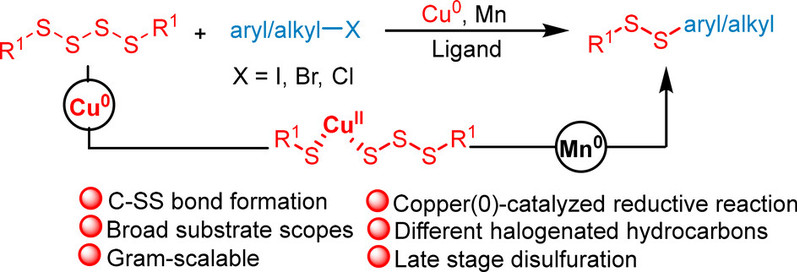Copper(0)-Catalyzed Reductive Coupling of Disulfurating Reagents and (Hetero)aryl/Alkyl Halides
Wang Chen1, Jiuwen Xu1, Weidong Rao2, Shu-Su Shen3, Zhao-Ying Yang, Lutz Ackermann5*, Shun-Yi Wang1*(汪顺义)
1Key Laboratory of Organic Synthesis of Jiangsu Province, College of Chemistry, Chemical Engineering and Materials Science, Collaborative Innovation Center of Suzhou Nano Science and Technology, Soochow University, Suzhou 215123, China
2Key Laboratory of Biomass-Based Green Fuels and Chemicals, College of Chemical Engineering,Nanjing Forestry University, Nanjing 210037, China
3School of Environmental Science and Engineering, Suzhou University of Science and Technology,Suzhou 215009, P. R. China
4Soochow College, Soochow University, Suzhou 215123, China
5Wöhler Research Institute for Sustainable Chemistry, Georg-August-Universität Göttingen, 37077 Göttingen, German
Org. Lett. 2024, 26, 8115−8120
Abstract: Herein, we reported a copper(0)-catalyzed reductive coupling of disulfurating reagents and (hetero)aryl/alkyl halides. Copper(0) can be directly inserted into tetrasulfide and then undergoes reductive coupling with (hetero)aryl Iodides to construct disulfide. The method features the unprecedented use of copper(0)-catalyzed disulfurating reagents (tetrasulfides) in cross-coupling chemistry and is convenient with broad substrate scopes, even applicable to different halogenated hydrocarbons. It is worth noting that the methodology is practical with the late-stage modification of bioactive scaffolds of pharmaceuticals. In the meantime, the synthesis of disulfides is successfully achieved on a gram scale, indicating the approach is highly valuable.

链接://pubs.acs.org/doi/10.1021/acs.orglett.4c03032